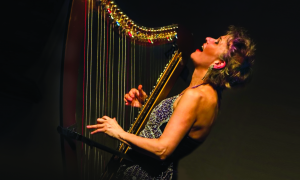Dave Pell is one of the founding fathers of West Coast jazz. After relocating to Los Angeles in 1944, Pell played on Bob Crosby's radio show and freelanced, joining Les Brown's band in 1947. In the years that followed Dave became one of California's most prolific studio musicians and ensemble leaders, forming a popular octet from the ranks of Brown's orchestra. Dave was a virtuoso player at an early age, able to mimic the sound and tone of virtually any popular tenor saxophonist.
In the early 1950s, Dave was instrumental in developing West Coast jazz's sound and mystique. An early developer of linear, “storytelling" jazz solos, he also earned extra cash as a photographer at the start of the 1950s. With a Rolleiflex, Dave documented the emerging West Coast jazz scene. He took dozens of cover photos, including the famous Gerry Mulligan Quartet 10-inch LP, Pacific Jazz's first release. Today Dave owns one of Lester Young's tenor saxophones and plays it regularly in concert, much to the delight of audiences. Young's only other known horn is at Rutgers University's Institute of Jazz Studies.
In Part 1 of my three-part conversation with Dave, 84, the legendary tenor saxophonist talks about his early days in New York, moving to Los Angeles in the mid-1940s, what he learned from Zoot Sims, and his years with the Les Brown band:
JazzWax: Where did you grow up?
Dave Pell: I'm originally from Brooklyn, N.Y. In the 1930s, my family lived in Brighton Beach before moving to Manhattan Beach there. By the time I was 14 years old, I was playing the clarinet. I had a terrific music teacher. He became thrilled with me and gave me a different exercise book every day. When I went to Abraham Lincoln High School, Sol Yaged was there. The bandmaster liked me so much he insisted I play solo chair. So he moved Sol over to the second chair. I didn't want to cause trouble, but the teacher insisted, saying he had never heard anyone like me before. I was very advanced at that age. [Photo of the Brooklyn Bridge in 1936 by Berenice Abbott]
JW: How did you become so skilled so quickly?
DP: My brother would take lessons, and I'd sit on the floor. When his lessons were over, I'd take his horn, replace his mouthpiece with mine and play the lesson he had just taken. I had remembered the entire thing. I was something of a prodigy, I guess, or virtuoso. I used to say to myself, “Wow, this is fun" when playing and practicing, not “This is work or a pain."
JW: Did you listen to jazz records as a kid?
DP: No. We couldn't afford them. Instead, I'd come home from school and listen to the radio all afternoon. When you're a mimic like I was, you can hear something and play and sound like it instantly. And you don't know why it happens that way. When Artie Shaw's Concerto for Clarinet came out in 1940, I heard it on the radio and played it note for note. Later, when I was at Capitol Records in the 1950s, I'd put together small bands and mimic all the great soloists, note for note. It's a skill I've always had.
JW: How did you wind up in Bobby Sherwood's band, your first professional gig?
DP: I was hanging around Nola Studios in New York in 1943, where all the rehearsing went on. I was 18 years old at the time and could play and read flawlessly. I was already getting a reputation for sounding like any of the big name soloists. If you wanted me to sound like Coleman Hawkins on Body and Soul, I could play Hawk's solo, note for note. Sometimes I'd memorize the transcribed solos they printed in Down Beat magazine at the time. Someone told me Bobby [pictured] was auditioning tenor players. So I went and got the job.
JW: When was your first trip to California?
DP: With Tony Pastor's band in 1945. I fell in love with the place as soon as we got there. I was young and having a lot of fun. Pastor's band was a terrific experience. I knew every solo that was coming up in a chart. When the solo neared, I'd race up front and beat him to the microphone [laughs]. I was hungry. And I loved it.
JW: Pastor wasn't angry?
DP: No, not at all. Pastor didn't mind. He didn't like playing. He preferred being a bandleader. The day we arrived in California, I told him I was going to leave the band. He flipped and said, “You can't leave. Who am I going to get out in this part of the country to fill your part?" [laughs]. That sounds like a strange thing to say but it was still early in the evolution out here, before L.A. became a magnet for band talent. Pastor begged me to stay, so I stayed for a few months. When the Pastor band left California for the East Coast, I stayed.
JW: Why do you love it so much?
DP: L.A. looked so great in the 1940s. First of all, the weather was fantastic all year round, which meant I could play golf every day. I also knew Zoot Sims well. He was from out here, from Inglewood. We played in Bobby Sherwood's band together in 1943. When I joined Sherwood, Zoot was playing tenor but wanted to play lead alto. So Bobby moved him into the alto chair and gave me all the Zoot features [solos]. Zoot was a year older than me and was by far the best tenor saxophonist I knew then--or ever. [Photo of Zoot Sims by Chuck Stewart]
JW: How did Zoot compare to Stan Getz in the late 1940s?
DP: Getz was good but nothing like Zoot. Zoot could swing and play better notes. He was a musician from the day he was born. All of his family members were musicians. Ray Sims, the trombonist, was his brother. Zoot knew how to swing. It was in his blood. He showed all of us that you didn't have to play so many notes to sound great. Even more important, he taught me how to make up little stories on the tenor when soloing. We were the first of the storyteller players out there.
JW: How did the storytelling work?
DP: Guys who can compose little stories on the spot while they solo make listeners smile. If you were a storyteller player, you did this by being comedic without being corny. We'd take little riffs or bits from songs we were playing and use them in a solo.
JW: How did Zoot do this?
DP: He'd start with a little story, repeat it and then put an ending on it. So all of us would try to do the same thing. We'd play around with the melodies. The next generation of great players like Coltrane wouldn't need this storytelling device. But Zoot and Al [pictured] and those of us who played like Lester [Young] used the story method. That's what Jimmy Giuffre's Four Brothers was about in '47. Each guy soloing was telling a story on the tenor. The better the story, the easier it was to sing in your head. This was Zoot's approach, which ultimately had a big impact on guys who played out here.
JW: After leaving Tony Pastor, you played with a lot of bands during the 1940s.
DP: Every time a band came into the Hollywood Palladium, the band's leader would need three or four guys to fill in for regulars who were out sick or needed a break. So I'd wind up playing in 15 different bands, including Frankie Carle, Freddy Martin and so many others. Only a half dozen guys could do that and grab the band's sound right off the bat.
JW: You also played with many small groups.
DP: Yes, there were all kinds of bands, including a Latin band led by Don Swan, who had done a lot of arranging for Xavier Cugat in the early 1940s. I also played in groups with Stan Getz [pictured] in the mid-40s when he was with Stan Kenton. He'd play beautifully in the dressing room. You couldn't believe what you heard back there. But he was a total dressing room player. When Stan got on stage, he'd get scared. His comfort level would change. You had to be flexible back then. You had to be able to play every style to get the freelance gigs in L.A. At this point, I could transpose a lead alto part on the spot and read it down on the tenor.
JW: You joined Les Brown in 1947 and stayed with him off and on through 1955.
DP: Around 1946, I started my own group and we played in Alhambra, a town close to L.A. One afternoon I got a call. It was Les Brown. He wanted to know if I could make his show. One of his saxophonists had gotten busted for drugs. I told him I had a gig but that I'd get a sub for me.
JW: You must have enjoyed playing with Brown given how long you remained with the band.
DP: Les [pictured] gave me and a couple of guys in the orchestra a chance to make the band into something it hadn't been. He had Don Fagerquist and Wes Hensel on trumpets, and fantastic arrangers like Hensel, Van Alexander, Skip Martin and Frank Comstock. The band started to get busy in the studios and accompanied Bob Hope on the radio. Then we were on TV shows with Hope, but TV shows needed more arrangements. Guys in the band started getting name value because there was so much work on a weekly basis.I gave up playing steadily with Les Brown in 1953, right around the time the small-group craze began in Los Angeles.
Tomorrow, Dave talks about playing with Gerry Mulligan at the Haig in May 1952, how the famous photo for the cover of the Gerry Mulligan Quartet LP was taken, and the reasons behind the rise of the West Coast studios in the early 1950s.
JazzWax tracks: There are two CDs that demonstrate beautifully the smooth, bop snap of Les Brown's band with Dave Pell in the late 1940s and the early 1950s. The first is Les Brown: S'Wonderful, 1949-50 Recordings. You'll find it here. Dig the arrangement of Where's Prez? Wow. The second CD is Palladium 1953, a spectacular concert recording with super hip arrangements of Caravan, Strange, Midnight Sun and Speak Low. You can download the album at iTunes or at Amazon. Or it's available on CD here.
This story appears courtesy of JazzWax by Marc Myers.
Copyright © 2026. All rights reserved.






















